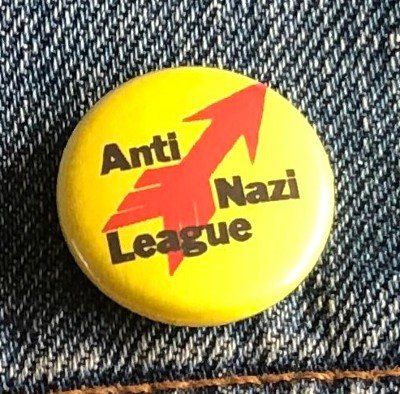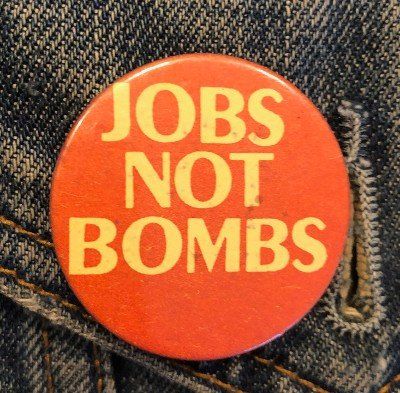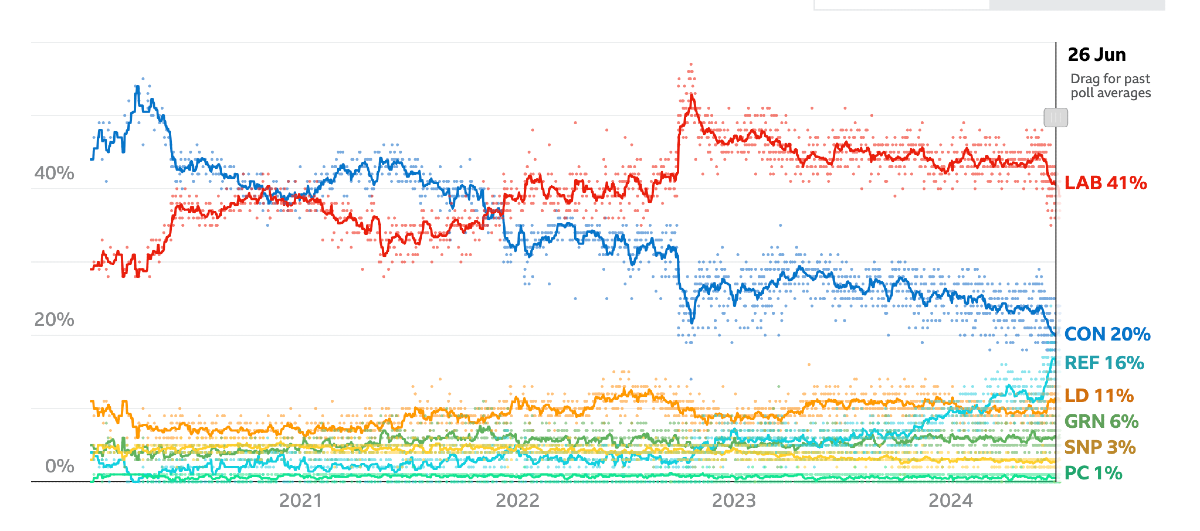Anti-Nazi League
This is one of the first badges I wore. The Anti-Nazi League was set up in 1977 to oppose the rise of far-right groups in the United Kingdom.
Above my desk I have a cork board that holds some of the badges I wore between 1978 and 1987. The badges were the inspiration for the title of my latest book: Badgeland.
Political badges - or campaign buttons as they are known in the U.S. - were very common throughout the 1970s and 1980s. We wore our badges on our chests with pride like twelfth century pilgrims who bought pewter badges to demonstrate their devout status.
Below is a brief summary of the badges which graced my denim jacket from 1978 to 1987.

Anti-Nazi League
This is one of the first badges I wore. The Anti-Nazi League was set up in 1977 to oppose the rise of far-right groups in the United Kingdom.

Rock against Racism
In response to the rise of the far right, Rock against Racism aimed to bring together black and white music fans and discourage young people embracing racism. On 30 April 1978, 100,000 people marched six miles from Trafalgar Square to Victoria Park in Hackney. The concert in the park included The Clash, Steel Pulse, Tom Robinson Band, and X-Ray Spex. I read about the concert in the NME in my bedroom in Swindon.

Campaign for Nuclear Disarmament
CND began in November 1957, its first president was Bertrand Russell. In the early 1980s following the election of Ronald Reagan CND's membership grew significantly. There were 90,000 national members and a further 250,000 in local branches.

CND Demo - 24 October 1981
In October 1981, I joined 250,000 people on an anti-nuclear weapons demonstration in London.

CND Demo - 22 Octiober 1983
On 22nd October 1983, I joined over 300,000 people demonstrated in London and more than three million protested across Europe against the deployment of Cruise missiles.

Tony Benn for Deputy
In 1981 Tony Benn ran for the deputy leadership of the Labour Party. The vote took place under a new electoral system that comprised 30% members, 30% MPs and 40% trade unions. Benn was defeated by Denis Healey by less than 1% of the vote.

People's March for Jobs
In 1981 and in 1983 there was a People’s March for Jobs in protest against high unemployment. The marches drew comparisons with the Jarrow March.

Jobs not Bombs
Unemployment passed 3m in the early 1980s.

Tories Out
I started wearing Tories Out badges in 1980, I never expected the Tories to be in power for anither 17 years. This badge is from a campaign to support the Militant candidate Dave Nellist in Coventry.

Free Nelson Mandela
In the early 1980s we were protesting against the imprisonment of Nelson Mandela by the apartheid South African government. In 1984 the Special AKA released the song Free Nelson Mandela. A number of protest songs achieved commercial success such as Ghost Town and A Town Called Malice.

Fight Racism
The early 80s saw a major campaign against racist apartheid in South Africa. There was a boycott of Barclays Bank and goods from South Africa.

Bermondsey By-Election 1983
On 24 February 1983 there was one of the most notorious by-elections. The Liberal Party ran a homophobic campaign with their male canvassers wearing, ‘I’ve been kissed by Peter Tatchell’ badges. Liberal leaflets asked, ‘Which Queen do you support?’
Labour lost the by-election. Gay News called it "the dirtiest and most notorious by-election in British political history." During the campaign Tatchell received over five hundred hate letters, thirty death threats and was also physically attacked over a hundred times.

Coal not Dole
The miners strike of 1984/85 was one of the most divisive strikes of the 1980s. Thatcher deliberately stockpiled coal and provoked a strike over pit closures in order to take on and defeat the National Union of Mineworkers.

Anti-Rate Capping Campaign
In 1984 the government introduced rate capping to allow central government control of council rates. Fifteen councils said they would refuse to set any budget at all for the financial year 1985–86. However, after Thatcher made it clear she would use the full force of the law against councillors, including surcharging them and banning them from office. All of the councils that initially refused to set a rate eventually did so, and the campaign failed to change government policy. Powers to restrict council budgets have remained in place ever since.

Campaign Against BT Privatisation
In 1984 Thatcher privatised British Telecom which became the model for future privatisations.

Keep GLC working for London
Thatcher sought to abolish the GLC after Labour took control under the leadership of Ken Livingstone. 75% of Londoners opposed the abolition but the council was abolished on 31 March 1986.
The council ran annual themed campaigns including anti-racism year (when it commissioned a sculpture of Nelson Mandela that still stands outside Festival Hall), peace year and jobs year.

Boycott Murdoch Newspapers
In 1986 print workers went on strike after Rupert Murdoch introduced new technology practices at Wapping that led to ninety-percent of printers being made redundant. The year-long strike failed and other newspapers adopted Murdoch’s new practices.

GLC works for Women
The GLC's Women's Committe was the first of its kind. It actively addressed issues of women's exclusion from policy development.

Nuclear Free Britain
I attended the CND demo and concert on April 25th 1987, one year after Chernobyl. Th ebadge features an image of a two headed sheep by Steve Bell, the then Guardian cartoonist.

Militant
This is my first Militant badge from 1979. By the early 1980s there were over 4,000 Militant supporters. After the election defeat in 1983 the Labour NEC agreed to ban sales of Militant at party meetings and began a process of expelling Militant supporters from the party.

Labour Party badges
Just some of my Labour Party badges from the 1980s.













